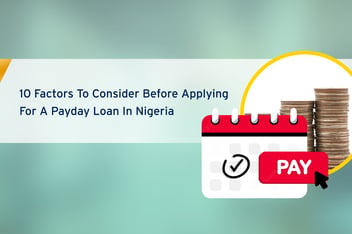
Author Eyitemi Efole
5 Practical Tips for Managing Existing Loans in a High CRR Environment
Introduction
The Cash Reserve Ratio (CRR) refers to the percentage of a bank's total deposits that must be kept in reserve, usually with the central bank, rather than being lent out. In a high CRR environment, banks have less capital to lend, often leading to higher interest rates on loans. Borrowers face increased challenges, including higher borrowing costs and reduced access to new credit. This makes managing existing loans more difficult, especially for individuals and businesses with multiple debts.
For Nigerians dealing with existing loans, whether it is payday loans, business loans, or mortgages, it is crucial to adjust their financial strategies in a high CRR environment. The following practical tips will help you manage your loans effectively.
1. Re-evaluate Loan Terms
When dealing with loans in a high CRR environment, it’s essential to explore every option to reduce costs
- Refinancing: Investigate the possibility of refinancing your loan to secure a lower interest rate. For example, some lenders offer refinancing deals for borrowers with good credit. Refinancing can save you thousands over the loan term. Switching to a fixed rate may provide better predictability if your current interest rate is variable.
- Loan Consolidation: This can help you combine multiple debts into a single loan, potentially lowering your monthly payments and simplifying your financial management. The goal is to find a lender offering a lower average interest rate than what you currently pay across your various debts.
- Extend the Loan Term: Although extending your loan term may increase the total interest paid over time, it can reduce the pressure on your monthly cash flow. If cash flow is tight, this strategy could provide immediate relief, though you should weigh the long-term cost.
Taking action early on loan terms, while the market is still adjusting to the high CRR, will give you better control over your financial situation. For a more detailed comparison of loan refinancing options, check out our loan comparison tool on nairaCompare
2. Prioritize Debt Repayment
In a high CRR environment, loan interest rates may increase, so prioritizing debt repayment becomes even more crucial. Begin by formulating a solid repayment strategy:
- Debt Snowball vs. Debt Avalanche: The Debt Snowball Method involves paying off smaller debts first, which can provide psychological motivation as you tick off each success. On the other hand, the Debt Avalanche Method focuses on repaying high-interest debts first, which can save more money over time.
- Timely Payments: Timely repayments are essential to avoid late fees and additional interest charges. Missed or delayed payments can drastically increase your financial burden. Automating payments through your bank can ensure you don’t miss any deadlines.
- Create a Repayment Plan: Using a spreadsheet or budgeting app, detail your current loans, interest rates, monthly payments, and repayment schedule.
With a clearer understanding of your debt obligations, you can better prioritize which debts to tackle first.
3. Leverage Debt Negotiation
If your financial situation has worsened due to rising costs or reduced cash flow in a high CRR environment, negotiating with your lender could be a practical solution.
- Request Lower Interest Rates: Approach your lender and explain your situation. Lenders often prefer to negotiate rather than have borrowers default on their loans.You might qualify for a lower interest rate or more flexible repayment terms if you've maintained a good repayment record.
- Restructure the Loan: If you find yourself struggling to meet payments, ask your lender if they offer loan restructuring options, such as temporarily reducing your payment amounts or deferring payments. Ensure that you understand any associated fees or increased interest that may result from such an arrangement.
- Effective Negotiation Tactics: Always go into a negotiation well-prepared. Present a clear case, including documentation of your financial hardship and any changes in your income or expenses.
Having a concrete proposal, like requesting a specific rate reduction or an extended payment period, shows that you're serious about repayment and not just stalling.
Debt negotiation requires patience and persistence, but it can make a significant difference in how you manage your existing loans.
4. Increase Income or Reduce Expenses
Maximizing your cash flow is key when managing existing loans under tough economic conditions. This can be done by either increasing income or cutting expenses.
1. Explore Side Hustles or Freelance Work: In Nigeria, there are several opportunities for freelance work, from writing and digital marketing to graphic design and tutoring. Websites like Upwork or Fiverr can help you find freelance gigs to supplement your primary income.
2. Cutting Non-Essential Expenses: Look at your budget critically to see where you can reduce costs. For instance, instead of dining out, cook meals at home. Review subscriptions you no longer need or use (like streaming services or gym memberships) and cancel them. Every saved naira counts toward increasing the amount you can put towards debt repayment.
3. Automate Savings and Set Limits: Utilize financial apps or set up automated transfers to a savings account as soon as your paycheck hits. This ensures that a portion of your income is set aside for loan payments before it's spent on discretionary purchases.
By balancing these two strategies—earning more and spending less—you’ll free up more funds to accelerate your debt repayment
5. Seek Professional Financial Advice
Navigating debt in a high CRR environment can be complex, and sometimes it's beneficial to consult with a financial expert.
1. Personalized Debt Management Plan: A financial advisor can help you create a customized plan that includes your income, existing debts, and long-term financial goals. They can also offer insights on whether refinancing, consolidation, or other strategies would be most beneficial for your specific situation.
2. Understanding the Bigger Picture: Beyond managing debt, a financial advisor can help you align your debt repayment strategies with other financial objectives, such as saving for retirement or building an emergency fund. Their expertise can save you from making costly mistakes.
Build a Strong Emergency Fund
High CRR environments can create economic instability, which may affect cash flow and your ability to meet loan obligations. Building or maintaining a robust emergency fund is essential to safeguard against unexpected financial difficulties.
- Aim to save at least 3-6 months’ worth of living expenses to cover any shortfall in income or unexpected loan payments.
- If your income allows, try to automate savings contributions to ensure consistent growth of your emergency fund.
- Avoid dipping into your emergency fund unless it’s absolutely necessary, such as in case of unemployment or medical emergencies.
Conclusion
Managing loans in a high CRR environment requires proactive steps, from reevaluating your loan terms to seeking professional advice. By prioritizing debt repayment, increasing your income, and negotiating with lenders, you can navigate this challenging economic landscape more effectively.
Remember, staying proactive is key. Small, consistent actions, like reducing non-essential expenses or securing better loan terms, can compound into significant financial relief over time.
Clcik the button below to compare and apply for loans, savings, and investments products.
About Author







